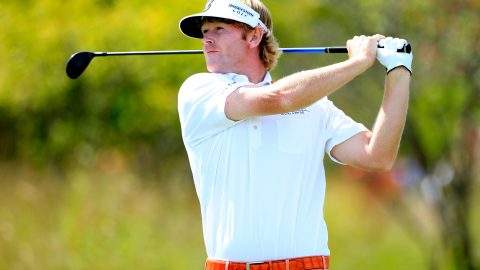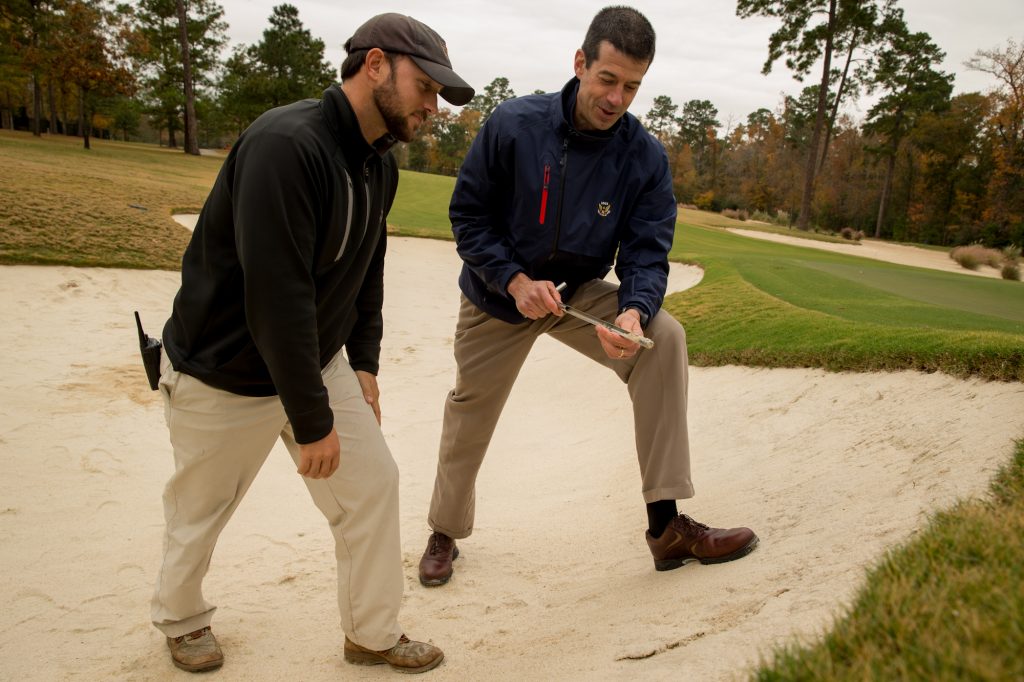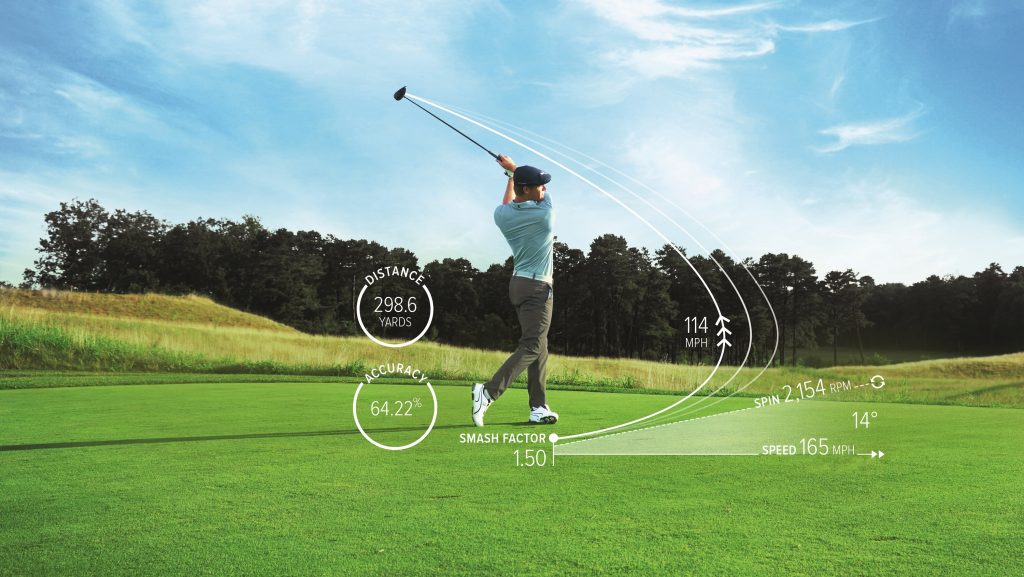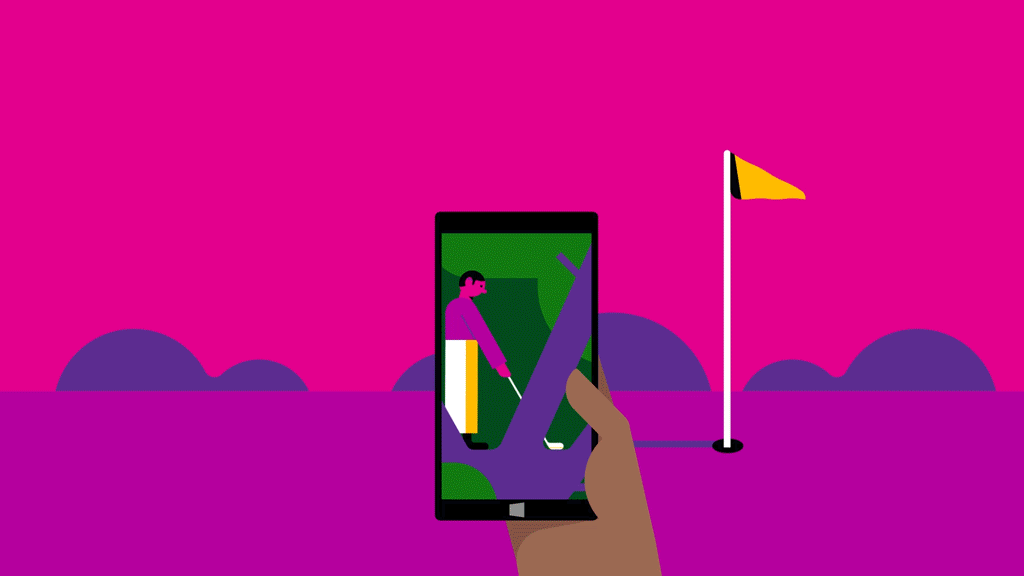Don’t let the pencils fool you: Golfers are teeing up a tech revolution
Watch any golf tournament, and you’ll see the sport’s greatest players walking around with some indispensable equipment: a stubby pencil and a paper booklet.
That’s what professional golfers use to keep score and make notes on yardage. Mobile devices aren’t allowed during competition.
But don’t let that quaint sight fool you. One of the oldest, most traditional sports in the world is well into a technological revolution, with every aspect of the game – a player’s swing and strategy, the equipment, course maintenance and even business models – transforming through scientific advances, data analysis, machine learning and the cloud.
With a heritage dating back to 15th-century Scotland, 18-hole golf takes pride in maintaining its tradition and etiquette. But obstacles such as cost, complexity and the time it takes to play can deter beginners. So those charged with preserving and growing the game – the USGA, PGA of America, LPGA and PGA TOUR – are developing technological solutions to help make it more accessible to modern players and fans.
Brandt Snedeker was famously one of golf’s most traditional professional players. But he swapped out his 10-year-old driver in 2015 for a new one sporting the latest advances in equipment design and discovered he hit further and straighter than ever. Now the 36-year-old, who’s been golfing since childhood, is fully embracing technology with tracking and data analysis, not just his clubs, and it’s paying off in his game – his world ranking had fallen to 58th in 2014 and has steadily built back up to 24th now.

“We track everything with radar now, and it tells you how you swing the club and what spin you put on the golf ball,” Snedeker said. “So I can see that when I have an ideal swing, I’m launching it at 12 degrees with a spin rate of 2,400 revolutions per minute, and when I test a new driver, I can find that launch and spin as my baseline and go from there.
“All this data wasn’t available five years ago, but now it gives you quantitative proof of what used to be feel-based,” he said. “It’ll never take the place of getting out on the golf course and knowing how to hit a hook shot, but now you know what a hook shot should feel like and how to get the numbers to add up. You’re reinforcing feel, providing concrete proof with new technology.”
Some of that new technology is easy to explain and understand. Other efforts are more obscure, belying the excitement behind them.
Take the PGA TOUR’s factually named Content Relevancy Engine, or CRE. “Tell folks that’s just the internal code name while we come up with something better,” laughed Steve Evans, the TOUR’s senior vice president of information systems.
The CRE is one of the projects Microsoft is working on as the Official Analytics Partner of the PGA TOUR. With Azure cloud-based services, the CRE will analyze the organization’s content dating back to 1916, including video, stats, scoring, photos and social media posts, and use it all to provide relevant, real-time information during tournaments.
“If Patrick Rodgers hits a shot into the 17th fairway, and it’s the final round of the event and he’s one shot behind the leader, that’s good to know, but tell me more,” Evans said. “Tell me that he has 145 yards left to the hole, that he ranks 10th on the TOUR in proximity from that yardage, and that he has a 20 percent chance of making a birdie on this hole. Or, if he hits into the sand trap, tell me the context that no one has been able to get in the hole out of that sand trap in less than three shots all week. Give me the context so that I know what a great shot it is if he makes it.”
The TOUR envisions letting broadcasters use the CRE for their commentary, and as work on the system progresses, distributing it on the organization’s website and through social media to help boost fan engagement. If a golfer hit an unusual shot from halfway up a tree, for example, the CRE could instantly entertain viewers by offering more videos that show shots from other improbable locations, such as hotel balconies.
“The TOUR is really trailblazing here in terms of addressing fan engagement this way,” said Scott Gutterman, the organization’s vice president of digital operations.
Another goal of the CRE is providing the context needed to encourage amateur players.
“In golf you only see the best of the best on TV, without understanding that what they make look normal and easy is actually really hard,” Evans said. “In other sports, you see a variety of players. But in golf, if someone’s not making the shots, they fall off the leaderboard and disappear. If we can show how hard it is for even the best to make a 17-foot putt, and also show other relevant pieces of content and engage you more, we’ll expand our fan base – and the game of golf itself.”
Brian Wescott of Atlanta would agree. The amateur golfer’s phone is filled with apps related to the sport he loves. One shows which hole he’s on, letting his wife check to see when he’ll be done playing. Another uses GPS tracking to take the guesswork out of the distance between him and the hole. That fosters a sense of connection and understanding, he said.
“It enhances the experience to see that Davis Love III hit an eight-iron and is so many yards out, and then you compare that to what you would have done,” Wescott said during a beverage break in the clubhouse at the season-ending TOUR Championship in September in Atlanta. “You might think, ‘Oh that’s about what I hit,’ but then you see the data and realize, oh no it’s not. It gives you good perspective on just how great these players are.”
Wescott also relies on apps when he’s at tournaments to know what’s happening when he hears cheering across the course, or to live-stream an event at work when he can’t make it in person.
ShotLink Powered by CDW is the system those apps rely on, used around each tournament course to capture every shot a player hits. CDW and the PGA TOUR map the courses and use lasers that track the shots. The system continues to develop with new apps and devices by Microsoft to help the “walking scorer” volunteers monitor the ball positions.
The PGA TOUR pioneered this type of scoring system, and now it’s exploring putting live cameras on every green that would add more insight by following the ball as it moves, rather than just noting the starting and ending points, Evans said.
Golf is unique among sports in that it has 18 fields of play, as if there were games underway simultaneously at 18 stadiums, making it impossible to show all the action at once. On TV, coverage bounces around between leaders, while typically skipping those who aren’t in contention. But some fans want to be able to follow their favorites even if they’re not playing well that day.
A new PGA TOUR consumer app will help with that, available now for anyone with a Microsoft Surface device or a Windows 10 desktop. It’s also installed on Surface consoles in the hospitality tents at tournaments, giving details of what’s happening on the hole nearby – for example, that Justin Thomas is walking up to attempt a 9-foot putt there, and that he’s made 90 percent of his 9-foot putts – while also letting fans check out the play at other holes without having to trek there.
When ShotLink was launched in 2001, the PGA TOUR created about 500 new statistics to rank players with all the new data it suddenly had. About five years ago, the organization collaborated with Columbia University Professor Mark Broadie on the new “strokes gained” metric, showing how each player performs against competitors at tournaments in four categories. It was another evolution in the history of golf scoring, beyond the century-old “par” concept that determines the number of strokes it should take a first-rate golfer to complete each hole and the “par relative” and “basic golf stats” metrics that followed.
Now, many professionals have begun employing data analysts to dig deeper and provide strategic insights into how to play a specific golf course, including where to place their shots to get the best statistical chance of getting the ball in the hole with the fewest strokes, Evans said. Meetings with the pros are planned for early this year to develop a player analytics program they can use for their own advanced analysis of their performance.
Separately, Microsoft quietly worked side by side with a data consultant on statistical analysis to help the U.S. team win the PGA of America’s Ryder Cup in October, in part by helping the team’s leaders better visualize the data to make more informed decisions about which players to select.
“Baseball broke the mold with the ‘Moneyball’ approach, and it’s been fascinating to watch it permeate all sports – now including golf,” said Jeff Price, the PGA of America’s chief commercial officer. The organization manages 28,000 professional instructors.
As recently as a decade ago, when people talked about technological advances in golf, they were referring to the equipment – improvements such as graphite shafts, aerodynamic ball design, and metal drivers instead of wood – and not much else. There are still plenty of courses where mobile phones aren’t allowed, demonstrating the traditional tendencies of the game.
“There wasn’t a ton of science applied to golf until the late 1980s,” the TOUR’s Evans said. “So even 25 years ago, people were skeptical about technology in golf. But that’s all shifted over the past eight years or so.”
The annual PGA Merchandise Show, which took place in Orlando last month, used to be known primarily as the place where new clubs, balls and footwear were introduced. Now, it includes software platforms for instruction and for tracking performance, along with dazzlers such as connected golf carts that have technology embedded into them.
The surprising embrace of technology in such a traditional sport is being driven by the adoption of mobile devices into everyday lives, now bleeding into golf.
“There’s an energy around innovation in the sport that is palpable in a very real way now,” said Sarah Hirshland, the USGA’s senior managing director of business affairs. “There will always be traditionalists and purists in golf, but by far the movement to innovate and create is more powerful.”
There’s no solid proof yet that technology is helping the game grow, Hirshland said. But there are positive signs. The number of rounds played at U.S. golf facilities was up 0.6 percent in 2016, the first increase in back-to-back years in a decade, Price said. Youth programs, in particular, are now bearing fruit, he said.
PGA of America instructors are using technology to help amateurs enjoy the game more by playing better, Price said. Tools that analyze players’ swings are no longer just for the driving range – new sensor systems can track how someone is doing through a whole round on the course so they can then show the golf pro to figure out what improvements might be needed.
The problem is that the tech “is coming faster than anyone can decipher, with all the various things that can now be measured,” Price said. “So we’re trying to help synthesize all these disparate points of data so professionals can figure out how to engage with it and make it relevant to their students.”

The USGA runs a handicap computation system called GHIN, or the Golfer Handicap Information Network, that puts course ratings and player scoring through an algorithm to help folks play together on an equitable basis, regardless of skill or age. More than two million golfers have an official handicap and are connected through the system, which has been in place since 1981 and records more than 50 million scores annually.
Now the group is analyzing GHIN to see if it can harness advances in data analytics and technology such as GPS to provide better information to players. The goal is to encourage social and intellectual connections by improving the way golfing is tracked and shared, through a dashboard that aggregates and distributes data so golfers can more easily compare their game against others’ to gain insight into how they’re playing, Hirshland said.
“We’re thinking of GHIN almost like a health record, for those who want to keep track of their golf lives all in one place, including where, when, with whom they played and what scores they made,” she said. But it’s not just the aggregation that’s key. “We want to apply the insights and analytics from this incredible amount of data to gain share of heart and encourage golfers to engage and spend more of their emotional capital against golf.”
The idea is to create a professional-style benchmarking ability at the recreational level. “I’m a very, very average golfer,” Hirshland said, “but for me to know that perhaps I make birdies more often than most other golfers at my relative skill level would be a nice, positive reinforcement tool.” Or even, drawing from the professional strokes-gained theme, to let a player know how he fared in last Saturday’s round on a relative basis among the 150 others who played the municipal course that day. “Players could understand exactly what part of their game was ‘on,’ as opposed to coming home and saying, ‘I think I putted really well today,’” Hirshland said.
The group recognizes that many players enjoy the golf course as a place to disconnect and don’t welcome the notion of mobile phones on the course – including about half of the 50 or older age group – while others use their phones constantly and view them as an asset, not a distraction. The key is to build platforms that provide choice, Hirshland said.

It’s not just the game – the business of golf is transforming, too. Facility operators are improving the golfer experience as well as their own financials by applying technological advances and data capture, Hirshland said.
A golf course generally covers 150 acres of land and requires a significant amount of water, fertilizer and daily maintenance, such as mowing grass and raking bunkers. It’s one of the largest expenses for a golf-course operator. So the USGA created a tool that uses GPS to track where golfers are actually playing, along with data analysis so courses can maintain only those areas, helping them save on labor, water and nutrients. During the 2015 year-long pilot program in Waco, Texas, the course reduced the amount of water and fertilizer used by 25 percent, which dropped straight to the bottom line. The USGA plans to roll out the program to other courses next month.
Course operators are also starting to think about tee-time rates the same way airlines and hotels use dynamic pricing to manage their yields and inventory, Price said. The old way – calling a course, picking a tee time, walking in and paying for either a daytime, twilight or weekend rate – is moving into mobile booking options where an 8 a.m. tee-time on a sunny Saturday is worth more than one at 4 p.m. on a rainy Tuesday. They’re also working on loyalty programs, Price said.
“We’re trying to shift from the dark ages of pen and paper to leverage technology for better experiences and better profitability, using these data points to move the business forward,” Price said. “The uniqueness in golf is this opportunity to create a bridge between a game that has great traditions and history that we want to respect, while using technology to modernize and innovate – and ultimately, get people to play more golf.”
Top photo: Professional golfer and early technology adopter Bryson DeChambeau at Metedeconk National Golf Club on July 25, 2016. Photo by Wally Pfister.









